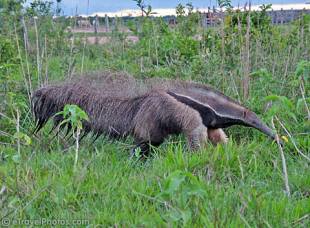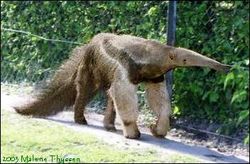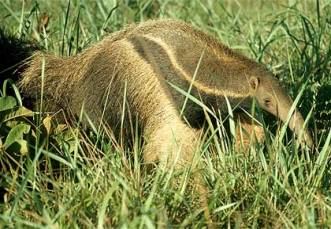General Article
Giant Anteater
Mr. Sankesh Pujari 04BCA55 (TYBCA)
|
|
The Giant Anteater, Myrmecophaga tridactyla, is the largest species of anteater. It is found in Central and South America. It is the only species in the Myrmecophaga genus. The giant anteater of South America is about the size of a German shepherd dog. It is covered with stiff, straw-like hair which grows up to 40 cm long on the tail. It is a solitary animal, found in many habitats, including grasslands, deciduous forests and rainforests. It feeds mainly on ants and termites, sometimes up to 30,000 insects in a single day. It grows to a size of 6 feet (1800mm) to 8 feet (2400mm) long, including a 3foot (900mm) to 4foot (1200mm) torso and tail. Generally it weighs from 65 (29 kg) to 140 pounds (65 kg). The Giant Anteater is one of only two mammals without any teeth even in a mature state . An ant eater instead crushes insects it consumes using hard growths found on the inside of its mouth, and its muscular stomach. Sand and small rocks have also been found in anteaters' stomachs, suggesting that these are ingested to aid digestion (possible gastroliths). The anteater will rip open a termite hill
with its clawed hand and work its tubular snout into the opening,
sticking its long, worm-shaped tongue down into the heart of the
colony and trapping the insects on its tongue’s sticky coating.
inoffensive by nature, the anteater’s principal enemies are the puma and the jaguar. These large predators must be careful in their attacks, however, as an embrace by the anteater’s powerful forelimbs can sometimes prove fatal. Giant anteaters are hunted in South America for their meat and for trophies. They are also killed because they are mistakenly believed to kill dogs and cattle, and, perhaps most frequently, because they are easy to kill. Despite its name, Myrmecophaga Tridactyla, from the Greek meaning 'three fingers', the anteater has five digits on each foot; however the middle three digits of the forefeet have elongated claws. These are extremely strong and are used to break open ant and termite mounds in order to feed, as well as effective defense from predators. The anteater walks on its knuckles in order to protect them, giving it a shuffling gait. The forefeet also have one other smaller claw, and the rear feet have five small claws.
The anteater has the longest tongue in relation to its body size of any mammal; its tongue can reach two feet (600mm) in length, with a width of only 1/2 inch (12.5mm). The anteater can cover its tongue in a sticky saliva, allowing it to trap ants, and can extend and withdraw it up to 150 times per minute. Jaguars (Pantheraonca) and (Pumas Puma concolor) are known predators. Giant anteaters can use their immense front claws to defend themselves from predators, though their typical response to threat is to run away. Their size makes them invulnerable to all but the largest of predators, jaguars and pumas primarily Giant anteaters eat ants, termites, and soft-bodied grubs. Using the long, sharp claws on their forelimbs, they open insect colonies and tree trunks. They then use the tongue to collect the eggs, larvae, and adult insects. The salivary glands secrete sticky saliva during feeding that coats the tongue. They only stay at one ant colony for a short period of time because soldier ants arrive but giant anteaters can consume a few thousand insects in minutes. The tongue is attached to the sternum and moves very quickly, flicking 150 times per minute. They sometimes eat fruit and eggs The mating system of M. tridactyla is not known. Reproductive behavior is primarily observed in captivity. The male stands over the female who lays on her side during copulation. Gestation is approximately 190 days, after which females give birth to a single young which weighs about 2.8 lb(1.3 kg). Females give birth standing up and immediately the young anteater climbs onto her back. Young are born with a full coat of hair and adult-like markings. Breeding occurs year-round in captivity and the wild, though seasonal breeding times have been reported in portions of their range. Inter-birth intervals can be as low as 9 months. Sexual maturity is reached between 2.5 and 4 years. The mammary glands are lateral to the 'armpits' on the chest.
|
|


